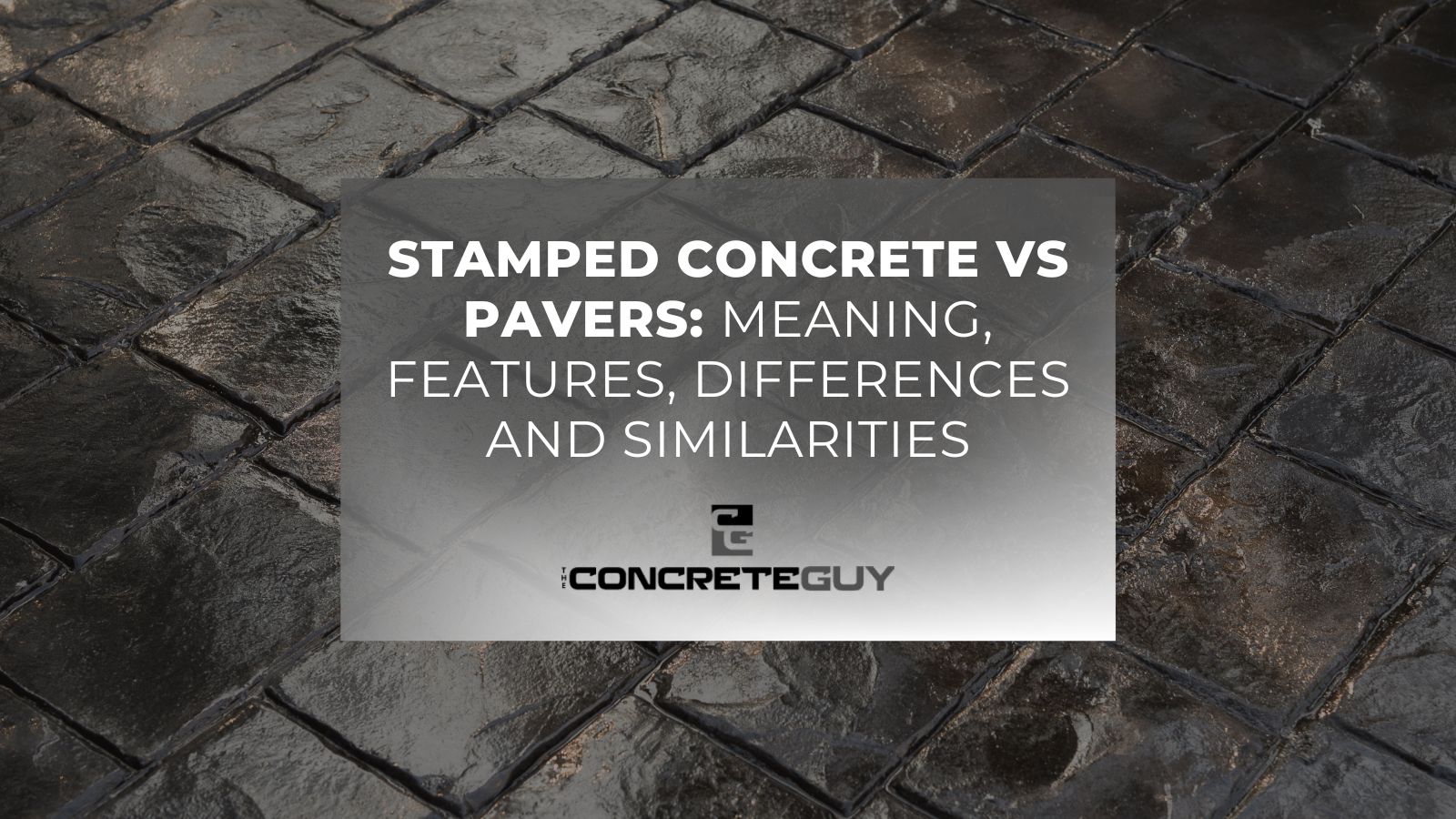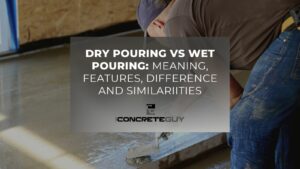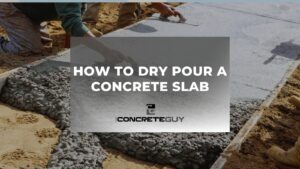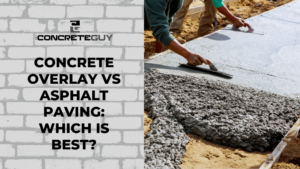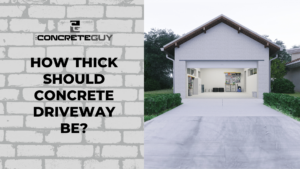Stamped concrete, also known as patterned or imprinted concrete, involves pouring a concrete slab and then impressing patterns and textures onto its surface to mimic the appearance of natural materials such as brick, stone, or tile.
Pavers are units made from various materials such as concrete, clay, brick, or natural stone.
Stamped concrete offers versatility and affordability for outdoor surfaces. It replicates the look of brick, stone, tile, and wood, providing numerous design options. Minimal maintenance is needed once sealed, making it convenient for homeowners. Stamped concrete is durable, enduring outdoor conditions for many years with proper upkeep. Its ability to blend seamlessly with landscaping and architectural elements enhances its appeal, enabling homeowners to craft personalized outdoor spaces.
The difference between stamped concrete and pavers is that the former is poured and stamped onsite, while pavers are installed individually. Stamped concrete is more uniform, whereas pavers offer a varied surface.
The similarities are that stamped concrete and pavers provide durable outdoor surfaces that mimic natural materials. They offer design flexibility with various patterns, colors, and textures and enhance curb appeal and property value.
What Is Stamped Concrete vs. Pavers?
Stamped concrete is a type of concrete that is patterned and/or textured to resemble various materials such as stone, brick, and slate. It is created by pressing molds into the surface of freshly poured concrete, which creates the desired pattern or texture. Stamped concrete is colored to amplify its appearance. It is a popular choice for patios, driveways, walkways, and pool decks due to its durability, low maintenance, and versatility.
Pavers are singular units made of concrete, brick, or natural stone that are laid in a pattern to create a paved surface. They come in various shapes, sizes, and colors, allowing for a wide range of design possibilities. Pavers are also durable and low maintenance, making them suitable for high-traffic areas.
What Are the Features of Stamped Concrete?
The features of stamped concrete include:
- Versatility: Stamped concrete offers a wide range of design options, allowing it to replicate the appearance of various materials such as brick, stone, tile, and wood.
- Cost-effectiveness: It is often more affordable than natural stone or brick, making it a budget-friendly option for homeowners.
- Low maintenance: Once sealed, stamped concrete requires minimal upkeep, typically needing only occasional cleaning and resealing every few years to maintain its appearance and durability.
- Durability: Properly installed and maintained stamped concrete withstands heavy foot traffic and the elements, lasting for decades without substantial wear or damage.
- Customization: Stamped concrete allows for personalized designs with different patterns, colors, and textures, enabling homeowners to create unique outdoor spaces that reflect their style and preferences.
- Seamless integration: Stamped concrete is seamlessly integrated with existing landscaping features and architectural elements, enhancing the overall aesthetic appeal of outdoor environments.
- Rapid installation: Compared to other paving materials, stamped concrete is installed relatively quickly, reducing construction time and minimizing disruption to the property.
What Are the Features of Pavers?
The features of pavers consist:
- Design flexibility: Pavers offer a wide range of shapes, sizes, colors, and textures, allowing for endless design possibilities and customization options to suit any aesthetic preference.
- Durability: Pavers are highly durable and cope with heavy foot traffic, harsh weather conditions, and the effects of freeze-thaw cycles without cracking or deteriorating, ensuring long-term performance and longevity.
- Ease of repair: In the event of damage or staining, individual pavers are easily replaced without the need to disrupt the entire surface, making repairs quick, convenient, and cost-effective.
- Slip resistance: Many pavers feature textured surfaces that provide excellent traction and slip resistance, making them ideal for outdoor areas such as driveways, walkways, and pool decks where safety is a concern.
- Sustainability: Pavers are often made from natural materials such as clay, concrete, or stone, making them environmentally friendly options sourced sustainably and have minimal impact on the environment.
- Low maintenance: Once installed, pavers require minimal maintenance, typically only needing occasional cleaning to remove dirt, debris, and stains to keep them looking their best.
- Versatility: Pavers are used in a variety of applications, including patios, driveways, walkways, and retaining walls, offering versatility and flexibility in design and functionality.
- Increased property value: Installing pavers upgrades the curb appeal and resale value of a property, making them a worthwhile investment for homeowners looking to improve the aesthetic appeal and value of their outdoor living spaces.
What Are the Differences Between Stamped Concrete and Pavers?
The differences between stamped concrete and pavers include:
- Installation method: Stamped concrete is poured and stamped onsite, resulting in a continuous surface, while pavers are installed individually, allowing for greater precision and customization.
- Appearance: Stamped concrete has a more uniform appearance, resembling the texture and pattern of natural materials, whereas pavers offer a varied and textured surface due to the individual units.
- Maintenance: Stamped concrete requires periodic resealing to protect against staining and fading, while pavers need occasional re-leveling or replacement of damaged units.
- Durability: Stamped concrete is prone to cracking and fading over time, especially in regions with freeze-thaw cycles, whereas pavers are generally more resistant to such issues, lasting for decades with proper maintenance.
- Repairability: In the event of damage, individual pavers are easily replaced without disrupting the entire surface, whereas repairing stamped concrete requires more extensive work and does not always match the original appearance.
- Cost: Stamped concrete is often more affordable than pavers initially, but the long-term maintenance costs need to be borne in mind. Pavers have a higher upfront cost but offer better durability and lower maintenance expenses over time.
What Are the Similarities Between Stamped Concrete and Pavers?
While stamped concrete and pavers differ in materials, installation, cost, and maintenance, they also share several similarities, especially in their application as decorative outdoor surfaces. Here are some key similarities between stamped concrete and pavers:
- Aesthetic Appeal: Stamped concrete and pavers offer a wide range of design options and aesthetic appeal. They mimic natural materials such as stone, brick, tile, and wood, providing versatility in creating visually stunning outdoor spaces.
- Customization: The options allow for customization in terms of patterns, textures, colors, and designs. Whether you prefer a rustic cobblestone look, a modern geometric pattern, or a classic brick layout, stamped concrete and pavers achieve your desired aesthetic.
- Versatility: Stamped concrete and pavers are versatile choices suitable for various outdoor surfaces, including patios, driveways, walkways, pool decks, and courtyards. They complement different architectural styles and landscaping themes.
- Durable: When properly installed and maintained, stamped concrete and pavers are durable and bear up against foot traffic, weather exposure, and normal wear and tear. They offer long-lasting performance in outdoor environments.
- Resistant to Stains: They are sealed to bolster resistance to stains, UV exposure, and color fading. Sealants help protect the surface and preserve the aesthetics of stamped concrete and pavers over time.
- Low Maintenance: While maintenance requirements are dissimilar, stamped concrete and pavers are relatively low-maintenance outdoor surface options. Regular cleaning, occasional resealing (for stamped concrete), and minor repairs, as needed, prolong their lifespan and appearance.
- Increased Property Value: Adding stamped concrete or pavers to outdoor spaces intensifies the curb appeal and value of a property. They are attractive features that contribute to a well-designed and functional outdoor living area.
- DIY-Friendly Options: While professional installation is recommended for optimal results, there are DIY-friendly stamped concrete and paver kits available for homeowners who prefer to tackle smaller projects themselves.
- Environmentally Friendly Options: Some manufacturers offer eco-friendly stamped concrete and pavers made from recycled materials or sustainable sources, contributing to green building practices and environmental sustainability.
- Temperature Regulation: Both stamped concrete and pavers regulate surface temperatures, making them comfortable to walk on during hot weather compared to materials like asphalt or traditional concrete.
What are the environmental impacts of Stamped concrete and Pavers? Factors to consider
The environmental impact of choosing between stamped concrete and pavers depends on various factors, including the materials used, manufacturing processes, and long-term sustainability considerations.
When evaluating the environmental impact of stamped concrete versus pavers, ponder factors such as resource extraction, energy consumption, waste generation, and the potential for recycling or reuse. Additionally, assessing the long-term durability and maintenance requirements of each option provides insights into their overall sustainability.
Choosing locally sourced materials, using recycled content where possible, and selecting permeable pavers or green paving solutions help minimize the environmental footprint of outdoor construction projects.
What is the environmental impact of Stamped Concrete?
The environmental impact of stamped concrete primarily revolves around the production of cement, which is a key ingredient. Cement production is energy-intensive and contributes to carbon dioxide emissions, a major greenhouse gas. Moreover, the mining and extraction of raw materials such as limestone and sand lead to habitat destruction, soil erosion, and depletion of natural resources.
However, advancements in cement manufacturing technology have led to improvements in energy efficiency and emissions reduction. Furthermore, the durability and longevity of stamped concrete mitigate its environmental impact by reducing the need for frequent replacement and maintenance.
What is the environmental impact of Pavers?
Pavers are often made from natural materials such as clay, concrete, or stone, which have varying environmental impacts depending on their sourcing and manufacturing processes. Clay pavers are manufactured from locally sourced clay and fired in kilns, which require energy but are more environmentally friendly than other materials.
Concrete pavers are made from cement, aggregates, and water, similar to stamped concrete, but their smaller size and modular construction result in lower overall material usage and waste. Natural stone pavers, while aesthetically appealing, involve more intensive quarrying processes and transportation, leading to higher carbon emissions and environmental disruption.
How do stamped concrete and pavers compare in terms of maintenance requirements?
Stamped concrete typically requires periodic sealing every few years to protect against stains, fading, and wear. Regular cleaning with mild detergent and water is also recommended. Pavers necessitate occasional cleaning and re-sanding of joints to prevent weed growth and maintain stability. These options have relatively low maintenance prerequisites but benefit from routine care to preserve their appearance and longevity.
What is the difference between asphalt paving and pavers?
Asphalt paving involves laying a mixture of crushed stone, sand, and asphalt binder, which is then compacted to form a smooth, uniform surface. It’s cost-effective, quick to install, and provides a durable, blacktop finish that is ideal for roads and driveways. In contrast, pavers are individual paving stones made from concrete, brick, or natural stone that are laid and interlocked over a prepared base of sand and gravel. Pavers offer greater aesthetic variety and flexibility in design, enhance drainage, and can be easily removed or replaced. However, they typically require a more intricate and labor-intensive installation process and may cost more than asphalt.
Are stamped concrete and pavers suitable for all climates?
Stamped concrete and pavers are suitable for various climates, but their performance differs. Proper installation, use of quality materials, and maintenance practices are crucial factors in ensuring durability and weather resistance. Consider climate-specific factors such as freeze-thaw cycles, heat exposure, and precipitation levels when choosing between the two options.

